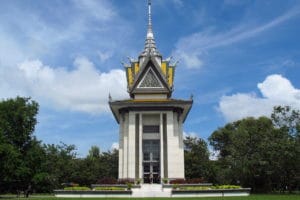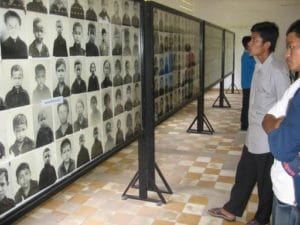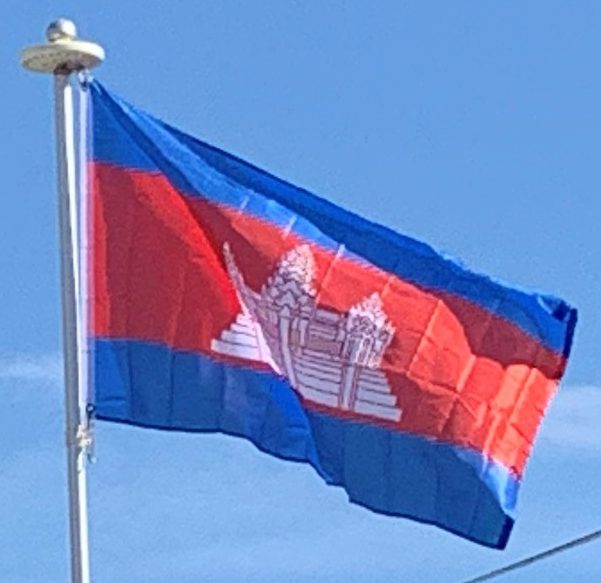
Estimates as to how many people were killed by the Khmer Rouge regime range from approximately one to three million; the most commonly cited figure is two million (about a quarter of the population). This era gave rise to the term Killing Fields, and the prison Tuol Sleng became notorious for its history of mass killing. Hundreds of thousands fled across the border into neighboring Thailand. The regime disproportionately targeted ethnic minority groups. The Cham Muslims suffered serious purges with as much as half of their population exterminated. Pol Pot was determined to keep his power and disenfranchise any enemies or potential threats, and thus increased his violent and aggressive actions against his people.
Professionals, such as doctors, lawyers and teachers, were also targeted. According to Robert D. Kaplan, “eyeglasses were as deadly as the yellow star” as they were seen as a sign of intellectualism.
Religious institutions were not spared by the Khmer Rouge either. Religion was so viciously persecuted to such a terrifying extent that the vast majority of Cambodia’s historic architecture, 95% of Cambodia’s Buddhist temples, was completely destroyed.
Vietnamese Occupation and Transition, 1978–1992:
In November 1978, Vietnamese troops invaded Cambodia in response to border raids by the Khmer Rouge. The People’s Republic of Kampuchea (PRK), a pro-Soviet state led by the Kampuchean People’s Revolutionary Party, a party created by the Vietnamese in 1951, and led by a group of Khmer Rouge who had fled Cambodia to avoid being purged by Pol Pot and Ta Mok, was established. It was fully beholden to the occupying Vietnamese army and under direction of the Vietnamese ambassador to Phnom Penh. Its arms came from Vietnam and the Soviet Union.

Peace efforts began in Paris in 1989 under the State of Cambodia, culminating two years later in October 1991 in a Paris Comprehensive Peace Settlement. The UN was given a mandate to enforce a ceasefire and deal with refugees and disarmament known as the United Nations Transitional Authority in Cambodia (UNTAC).
Restoration of the Monarchy:
In 1993, Norodom Sihanouk was restored as King of Cambodia, but all power was in the hands of the government established after the UNTAC sponsored elections. The stability established following the conflict was shaken in 1997 by a coup d’état led by the co-Prime Minister Hun Sen against the non-communist parties in the government. In recent years, reconstruction efforts have progressed and led to some political stability through a multiparty democracy under a constitutional monarchy.
In July 2010, Kang Kek Iew was the first Khmer Rouge member found guilty of war crimes and crimes against humanity in his role as the former commandant of the S21 extermination camp and he was sentenced to life in prison. However, Hun Sen has opposed extensive trials of former Khmer Rouge mass murderers.
In August 2014, a UN-backed war crimes tribunal, the Extraordinary Chambers in the Courts of Cambodia (also known as the Khmer Rouge Tribunal), sentenced Khieu Samphan, the regime’s 83-year-old former head of state, and Nuon Chea, its 88-year-old chief ideologue, to life in prison on war crimes charges for their role in the country’s terror period in the 1970s. The trial began in November 2011. Former Foreign Minister Ieng Sary died in 2013, while his wife, Social Affairs Minister Ieng Thirith, was deemed unfit to stand trial due to dementia in 2012. The group’s top leader, Pol Pot, died in 1998.
Geography:
Cambodia has an area of 69,898 square miles and lies entirely within the tropics. It borders Thailand to the north and west, Laos to the northeast, and Vietnam to the east and southeast. It has a 275-mile coastline along the Gulf of Thailand.
